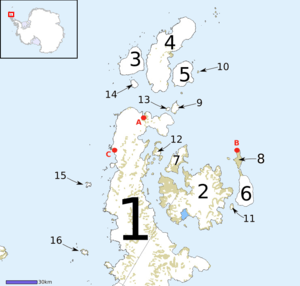Hope Bay incident
The Hope Bay incident occurred in February 1952 at Hope Bay on the Antarctic Peninsula. It involved an Argentine naval party from their on shore base and a British landing party from their survey ship.

Background
During the 19th century there had been increasing interest by various countries in the uninhabited, largely unexplored, and unclaimed continent of Antarctica and its many off-shore islands. The United Kingdom was first to lay formal claim which it did in Letters patent of 1908. This defined the boundaries of areas it claimed as dependencies of its Falkland Islands colony. One dependency was Graham Land on the Antarctic Peninsula, at the northern tip of which is Hope Bay.[1] Chile, in 1940, was next to define its claimed areas of Antarctica, and Argentina established its claim in several stages between 1940 and 1947. The claims of all three countries, including to the Antarctic Peninsula, overlapped.[2] The United States was also showing an interest in laying its own claim to the same area.[3]
The incident
.jpg)

In 1948, a British research base at Hope Bay was destroyed by fire and subsequently abandoned. It was operated by the Falkland Islands Dependencies Survey (FIDS). Soon afterwards, a manned Argentine base was established a few hundred metres away from the abandoned British base. In February 1952, the FIDS survey ship, John Biscoe, arrived with equipment and stores to rebuild the fire-damaged base. The Argentines warned off the landing party and fired a machine gun over their heads. The landing party then withdrew back to the John Biscoe which returned to the Falklands. The Governor of the Falkland Islands and its dependencies, Sir Miles Clifford, ignoring Foreign Office instructions to the contrary, boarded the frigate HMS Burghead Bay and, with an accompanying detachment of marines, escorted the John Biscoe back to Hope Bay, where they arrived on 4 February.[4] The show of strength forced the Argentines to retreat and provided protection while the British base was rebuilt.[5][6] On 7 February, while still on duty at Hope Bay, Burghead Bay ran aground in severe weather. This mishap prompted a court martial in November 1952. The frigate eventually limped to Stanley with the governor and its passengers on 10 February.[6]
The Argentine authorities had already issued an apology in the aftermath of the 1 February eviction of British personnel and said the commander at the base had exceeded his authority.[7] However, the real reason behind the incident was its likely propaganda value, as part of the Argentinian leader, Juan Peron's, nationalist Antarctic Dream.[8] In effect, when the Argentine base was relieved, Peron greeted the members of Esperanza Detachment with a hero's welcome.[9]
See also
References
- "Polar Record". CUP. December 1948. pp. 241–243. doi:10.1017/S003224740003792X. Retrieved 6 February 2020.
- Klotz, Frank G. (1998). "1". America on the Ice: Antarctic Policy Issues. Google Books: DIANE Publishing. pp. 9–10. ISBN 9780788170485. Retrieved 6 February 2020.
- Abbink, Benjamin Peter (2009). Antarctic Policymaking and Science in the Netherlands, Belgium and Germany (1957-1990). Google Books: Barkhuis. p. 23. ISBN 9789077922606. Retrieved 6 February 2020.
- "CLIFFORD, Sir (GEOFFREY) MILES 1897 - 1986". Dictionary of Falklands Biography including South Georgia. Retrieved 7 February 2020.
- Beck, Peter J. (2014). The International Politics of Antarctica. Google Books: Routledge. p. 35. ISBN 9781317700968. Retrieved 1 February 2020.
- "HMS Burghead Bay". Naval-History.Net. Retrieved 7 February 2020.
- "FALKLAND ISLANDS DEPENDENCIES (HOPE BAY INCIDENT) (Hansard, 20 February 1952)". api.parliament.uk. Retrieved 2020-02-28.
- Howkins, Aidrian (2017). Frozen Empires: An Environmental History of the Antarctic Peninsula. Google Books: Oxford University Press. p. 121. ISBN 9780190249144.
- Howkins, Adrian (2017). Frozen Empires: An Environmental History of the Antarctic Peninsula. Oxford University Press. p. 121. ISBN 9780190249144.